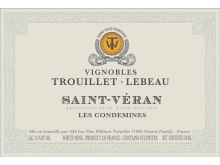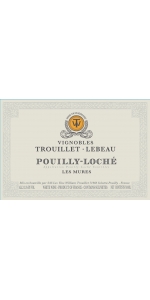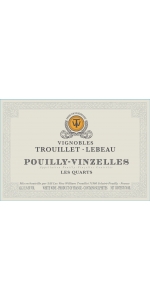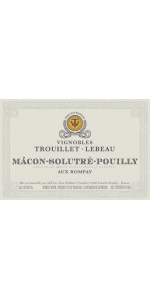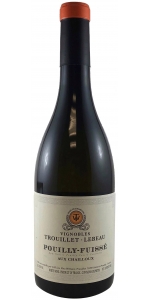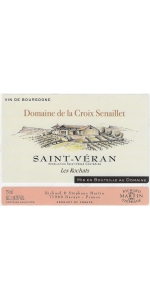Trouillet Lebeau St. Veran Les Condemines 2022
6 bottles with free shipping for: $270.00
12 bottles with free shipping for: $468.00
| BUY MORE! SAVE MORE! | ||||||||||||||||||||
|
| Country: | France |
| Region: | Burgundy |
| Winery: | Les Vins Trouillet Lebeau |
| Grape Type: | Chardonnay |
| Vintage: | 2022 |
| Bottle Size: | 750 ml |
Trouillet Lebeau St. Veran Les Condemines is made from 100 percent Chardonnay.
The wine comes from 70-year-old vines that are ideally located on a south-facing slope in the village of Leynes, on a clay-limestone terroir. Aged 100% in Burgundy barrels, offering a fruity, powerful and charming wine. Beautiful expressive aromas of ripe yellow fruits. Rich, generous, full, crisp and well-balanced on the palate.
Ideally situated at the foot of the famous rock of Solutré, in the hamlet of Pouilly, Les Vins Trouillet Lebeau – currently managed by Marie-Agnès (3rd generation) and her son William (4th generation) – extends over about twenty hectares today, which is a sign of excellent dynamism as Jules Guérin, Marie-Agnès’s grandfather, started with 4 hectares of share-cropped land (in the hamlet of Pouilly) which his son Jean worked for 45 year
Tillage is largely carried out to encourage underground life and root development, so as to obtain the richness and minerality required for quality reasons which enable great wines to be produced.
In the cellar: All of our grapes are pressed gently using a latest-generation pneumatic press and decanted very rigorously for 24 hours in order to obtain clear, pure grape juice. All vintages are vinified in oak vats, large barrels or casks from Burgundy, fully respecting the required temperatures in order to maintain all of the freshness and finesse of Chardonnay.
The Estate was founded by Jean Guérin.
Marie Agnès was the third generation winemaker in the Family.
William represents the 4th generation.
Our vines, which are on average 40 to 50 years old, are planted on clay-limestone soil in 6 villages surrounding the domaine: Soluté-Pouilly, Fuissé, Loché, Vinzelles, Leynes, and Davayé. They benefit from exceptional terroir of varying aspect, which produces a wide range of dry and fruity wines with great complexity, to please the most demanding palates.
Trouillet Lebeau Pouilly-Loche Les Mures is made from 100% Chardonnay.
Pouilly Loché is the smallest appellation in the Mâconnais (33 hectares). The climate called "Les Mures" is located on a hillside, facing east, overlooking the Saône Valley at an altitude of 250 meters, in the village of Loché, 5 kilometers south-east of Mâcon. Loché has been a site devoted to vines since the Roman times. Excavations during the construction of the TGV station, which puts this vineyard 1 hour 40 minutes from Paris and Geneva, revealed the foundations of a large villa. Thereafter, the vine flourished under the influence of the monks of Cluny, who are reminded of the magnificent 12th century octagonal bell tower behind which the rocks of Solutré and Vergisson stand out.
The wine offers delicate and precise aromas of ripe yellow fruits. Dense, fleshy and fruity in the mouth with a fresh menthol finish.
Trouillet Lebeau Pouilly-Vinzelles Les Quarts is made from 100 percent Chardonnay.
The wine comes from a very small parcel located in the climate of "Les Quarts" benefiting from an eastern exposure that is perfectly suited to Chardonnay, allowing early harvests and giving rich and powerful wines. Neighboring the archaeological complex of Solutré, the Vinzelles appellation is based on the same Jurassic (Bathonian and Bajocian) rocks that crown the Mâconnais mountains.
Rich aromas of peach, apricot and grapefruit, evolving with age towards fresh almond, hazelnut, honey, quince or toasted bread. This Pouilly-Vinzelles "Les Quarts" balances its natural minerality with fatness and opulence.
Trouillet Lebeau Macon Solutre Pouilly is made from 100 percent Chardonnay.
The Macon-Solutre-Pouilly is produced from the 2 hectare-parcel called "Au Rompay", which is the highest of the estate, located at the southern tip of the Mâconnais in the Mont Pouilly, across the famous Solutré Rock. The grapes are usually harvested in the very last days, bringing freshness and minerality to the wine.
The nose opens generously with sweet notes of candied and citrus fruits. The maturity and ripeness of the fruit combine with an aromatic freshness and a real delicacy in the mouth. The wine is structured, but still lively on the finish.
Trouillet Lebeau Pouilly Fuisse Premier Cru Pouilly 2021 is made from 100% Chardonnay.
This wine, now sold under the Premier Cru Pouilly AOC, is not new to our portfolio. This wine used to be called “Coeur de Pouilly” and it was the estate's latest Pouilly-Fuissé cuvée. Starting with the 2021 vintage, this climat is now officially classified as Premier Cru !
It comes from the best plots located in the heart of the appellation and aged in oak barrels. The wine shows a pale yellow color with deep golden highlights, an aromatic and complex nose with fruity (fresh almond, apricot) and floral (violet) notes. Powerful and fleshy in the mouth, it reveals notes of lime trees, cinnamon, honey and has a good aromatic persistence.
Enjoy it with poultry, such as Poulet de Bresse (blue-footed chicken) or with strong fish, such as pike or bass.
All older vintage wines have been purchased from a single collectors cellar. Pictures can be requested before shipment.
Croix Senaillet St. Veran Les Rochats is made from 100 percent Chardonnay.
This Saint Veran Les Rochats is produced from 50-year-old Chardonnay vines, grown organically on Jurassic-era limestone (Entroque limestone), covered by pebbles that act as a filtering soil. The parcel is southeast facing on half hills.
Clear golden color with light green reflections. The wine has a rich and complex bouquet with a wide array of aromas: pear, nougat, wild peach and kiwi. The mouth is rich and dense bringing freshness with a nice volume and finishing on a light exotic note.
Vineyard
Surface area : 1 Ha.
Soil : limestone soil from the Jurassic period, covered by pebbles acting like a filtering soil.
South-east facing parcel on half-hills.
Grape variety : organically-grown Chardonnay.
Plantation density : 8.500 vinestocks per ha.
Age of vines : 50 years.
Mâconnais style pruning quite short, with 10 to 12 buds.
Hand-harvesting at optimal maturity.
Destemming to avoid herbaceous taste.
Slow and gentle pneumatic pressuring guarantees purity of juice and extraction of the finest aromas.
Very slow alcoholic fermentation in stainless still tank.
Malolactic fermentation.
Aging in stainless steel tanks for 9 months with gentle stirring of fine lees.
Pairs well with shrimp risotto, sautéed veal with eggplant.
- back
Quintessa is made from 91% Cabernet Sauvignon, 4% Cabernet Franc, 3% Carménère, 1% Merlot, 1% Petit Verdot.
The 2021 unfolds with Quintessa's signature balance of complex fruit, precise structure, and vital freshness amplified by an especially beautiful growing season. Floral notes— violet and lilac—lift an intensely aromatic bouquet of cassis and black cherry accented with anise, bay laurel, and forest floor. On the palate, firm but fine-grained tannins back dark berry and savory herb flavors interwoven with graphite and iron. Generous texture carries the complex layers to a fine, chalky finish.
Review:
An exquisite wine, relying primarily on Cabernet Sauvignon from a single estate. Aromas of lavender, dried herbs and grapefruit pith combine with flavors of firm fruits and cocoa on a structure of abundant, powder-fine tannin and a mouthwatering finish. This wine is refined, detailed and delicious, with as much elegance as energy. Best 2026–2040.
Cellar Selection
-Wine Enthusiast 100 Points
Clos Saint-Jean is a 41-hectare estate in Châteauneuf-du-Pape run by brothers Vincent and Pascal Maurel. Considered by many critics and wine-writers as the preeminent estate espousing the modern style of winemaking in Châteauneuf, this cellar is one of the oldest in the region, having been founded in 1900 by the greatgreat-grandfather of Vincent and Pascal, Edmund Tacussel. A short time after its founding and well before the AOP of Chateauneuf-du-Pape was created in 1923, Edmund began bottling estate wines in 1910.
The farming at Clos Saint-Jean is fully sustainable due to the warm and dry climate, which prevents the need for chemical inputs. Instead, Vincent and Pascal employ organic methods for pest control, mainly pheromones, to prevent pests from taking up residence in their vines, a process called amusingly enough in French, confusion sexuelle. The vines tended manually, and harvest is conducted in several passes entirely by hand.
Combe des Fous literally means, the hill of the fool. The hill, in this case, is located in the far southern reach of Le Crau which was left barren for many centuries because the layer of galets was so exceedingly deep that everyone assumed vines could never survive there. The fool in this situation is Edmund Tacussel, the great-great-grandfather of Vincent and Pascal Maruel who planted a Grenache vineyard on this site in 1905. That old-vine Grenache form the heart of this cuvée with a small amount of Syrah, Cinsault and Vaccarèse. La Combe des Fous is only made in the best vintages.
Review:
This has good concentration and energy to the dense core of dark fruit and bitter cherry, with great poise and elegance despite its ripeness (an impressive feat for the vintage). Guided by finely crushed mineral accents and tannins, this reveals pretty high-toned floral notes and leafy tobacco. Grenache, Syrah, Mourvedre, Cinsault, Vaccarese and Muscardin. Drink now through 2032. 900 cases made.
-Wine Spectator 95 Points

